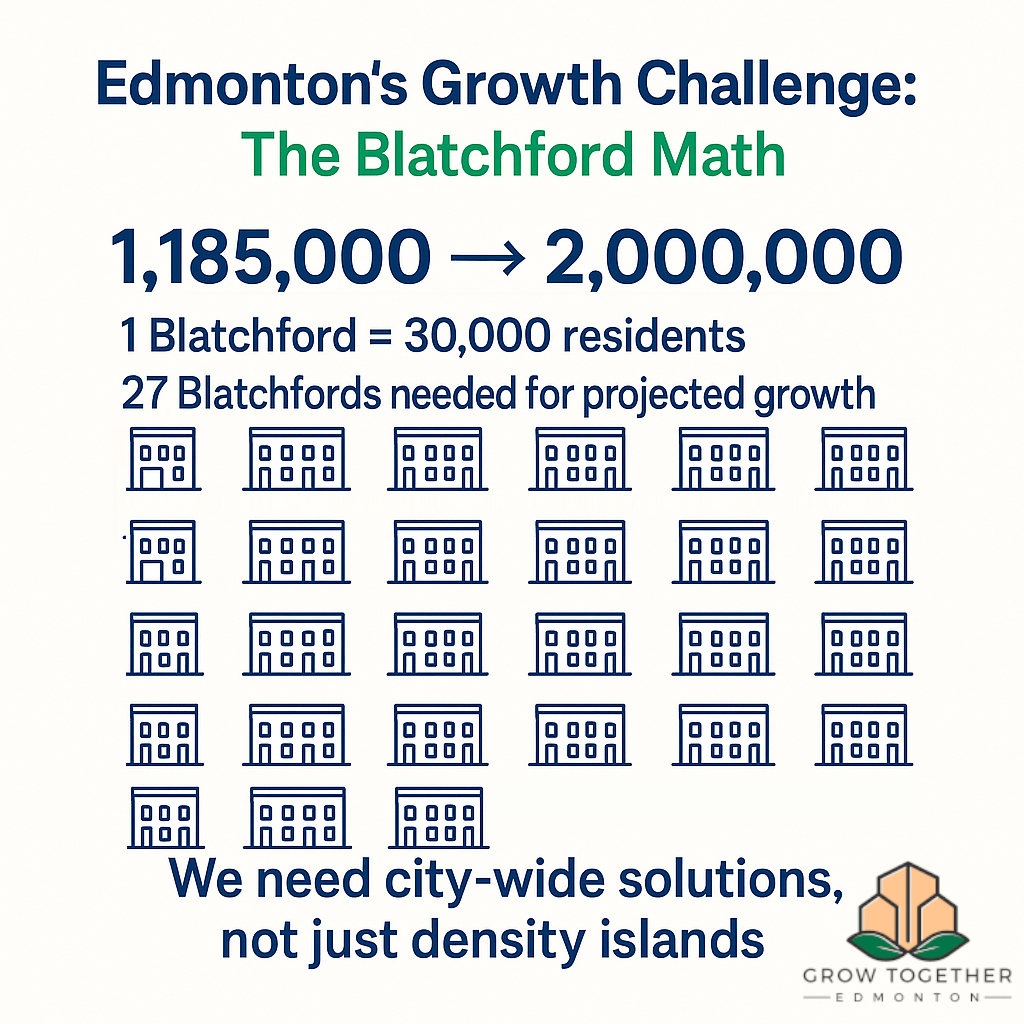
Edmonton is growing. With the Edmonton Metropolitan Region Board projecting the region could reach 2.2 million people by 2044 and the City of Edmonton predicting it could grow to two million people by 2040, the conversation around housing and density has never been more urgent. While developments like Blatchford and the Exhibition Lands redevelopment represent exciting steps forward in creating vibrant, dense communities, treating these areas as silver bullets for our housing crisis is a dangerous oversimplification.
The reality is stark: concentrating density in a handful of designated areas simply won't accommodate the scale of growth Edmonton faces. It's time for a more comprehensive approach that embraces density throughout our existing neighbourhoods.
Let's talk scale. Blatchford, when fully developed, will house approximately 30,000 residents across multiple housing types. The Exhibition Lands redevelopment will accommodate 7,511 people when fully built out. Combined, these flagship developments will house fewer than 38,000 people, significant numbers, but they represent a fraction of what Edmonton needs.
To put this in perspective, Edmonton's population has been growing rapidly, with the city experiencing a 5.73% year-over-year increase, and the City of Edmonton projecting nearly 100,000 more people will move to the city in the next three years. This means our Blatchford and the Exhibition lands, when completed over the next 15-20 years, will house less than one year's worth of recent population growth. Even with more conservative long-term growth projections, we'd need to build a new Blatchford every nine months just to keep pace with demand.
Consider this: if Edmonton's population grows by even 500,000 people over the next two decades, a conservative estimate, we'll need roughly 200,000 new housing units. Even if we built ten more Blatchfords, we'd still fall dramatically short of meeting demand. The math is unforgiving, and it demands a broader vision.
Concentrating density in specific areas also raises serious equity concerns. It risks creating a two-tier city where some neighbourhoods are allowed to evolve and grow while others remain frozen in time. This approach typically protects wealthier, established neighbourhoods from any change, while pushing growth to areas with less political resistance.
But this strategy backfires economically. When new housing supply is artificially constrained to only a few areas, it fails to relieve housing pressure throughout the city. The lack of new housing options in mature neighbourhoods means families looking for ground-oriented housing must compete for the same limited existing stock, pushing up prices and rents even in areas far from the designated "dense" zones. Working families, young professionals, and seniors on fixed incomes find themselves shut out of existing neighbourhoods as competition for the limited housing stock drives up prices and rents.
Allowing gentle density throughout the city ensures that all communities can contribute to solving our housing challenges while maintaining their distinct identities and keeping neighbourhoods accessible to people of all income levels. In fact, gentle density would enhance the character of many existing neighbourhoods by repopulating them back to the levels they had when originally built, before decades of household size decline left many areas less vibrant than they once were.
Cities across North America that have tried the "density island" approach have learned hard lessons. Vancouver's experience with concentrating density in specific areas led to housing unaffordability and lengthy commutes. Toronto's approach of creating density islands in areas like CityPlace, Yonge and Eglinton, and North York Centre, while protecting single-family neighbourhoods from change, has contributed to some of the continent's highest housing costs.
Successful cities like Montreal and Edmonton have embraced what planners call "missing middle" housing throughout their urban fabric. This approach, allowing multiplexes and small apartment buildings in existing neighbourhoods, creates housing options without fundamentally changing neighbourhood character.
Edmonton needs a comprehensive approach that includes both flagship developments like Blatchford and city-wide zoning reform that allows gentle density throughout existing neighborhoods. This means:
Zoning Reform: Allowing small-scale infill multiplexes in every neighbourhood in the city.
Transit-Oriented Development: Focusing density not just in new developments but around existing LRT stations and bus rapid transit corridors throughout the city.
Blatchford and the Exhibition Lands redevelopment are important pieces of Edmonton's housing puzzle, but they're just pieces. Solving our housing crisis requires embracing density as a city-wide solution, not a problem to be contained in specific areas.
Edmonton's future depends on becoming a city where families can afford to live, where young people can find housing, and where seniors can age in place. This future requires the courage to allow our neighbourhoods to evolve and grow, not the false comfort of concentrating change in isolated areas.
The question isn't whether Edmonton will grow, it's whether we'll grow in a way that serves all residents. The answer lies not in building higher walls around density, but in opening our neighbourhoods to the gentle, inclusive growth that will make Edmonton a more affordable, sustainable, and equitable city for everyone.